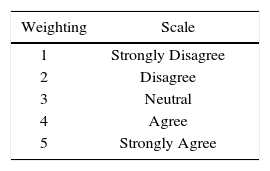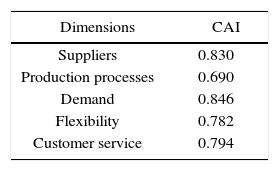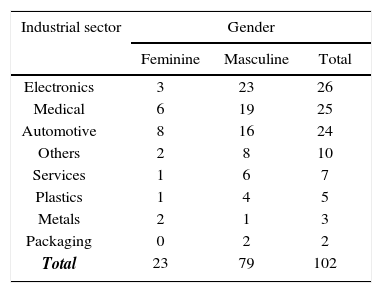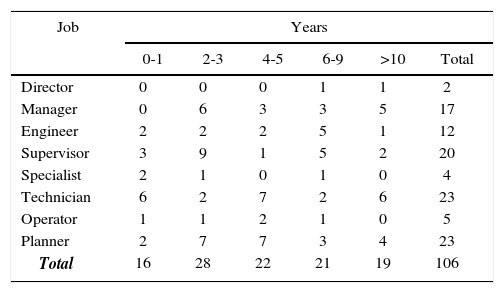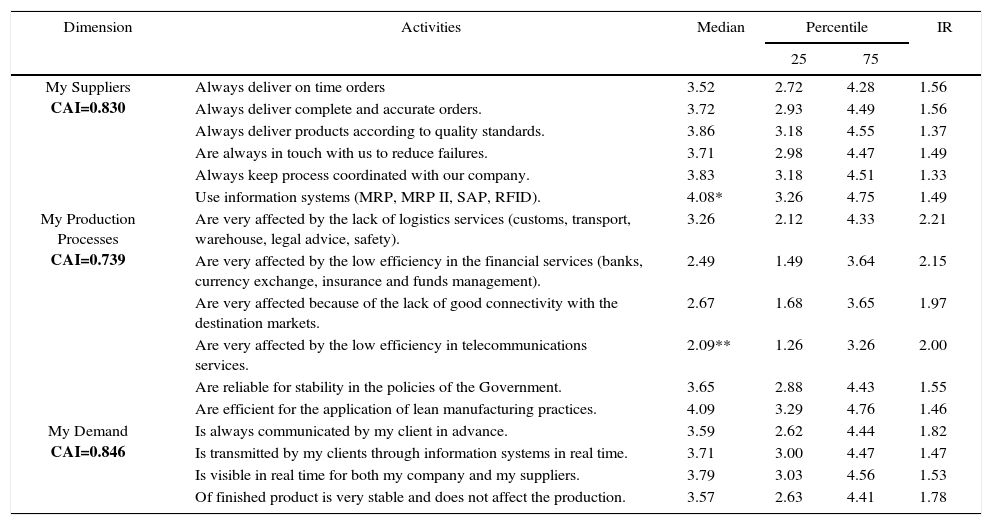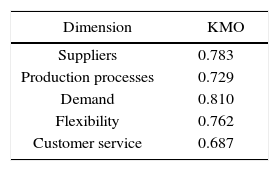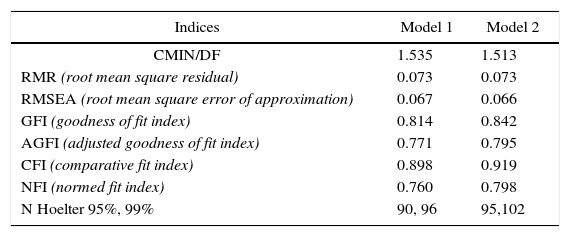This paper proposes a structural equation model to assess the effects of some risk factors in the supply chain performance. The model includes demand, suppliers and processes as risk factors of a case study in Ciudad Juarez, Chihuahua, México. The model, assessed following a structural equation modeling methodology (using AMOS 16.0), indicated that the demand (considered as an independent factor) has a direct positive relationship with suppliers, politics, and manufacturing factors. As a consequence the suppliers have an effect on the flexibility factor. The flexibility has a direct positive relationship with the customer service factor. The results also indicate that the infrastructure factor does not have any relationship with the others assessed factors. The study has important implications for researches and practitioners in the manufacturing sector. It allows evaluating risk activities that have negative effects on the performance of supply chain in manufacturing exports companies in México.
In today’s world, supply chains will focus on mastering changing markets with requirements such as being competitive in delivering products on time, low costs, shorts cycle times and better quality. Plus, the ability to efficiently manage global supply chain is considered a vital source of competitive advantage.
In this paper the supply chain (SC) is defined as a network of firms connected by flows of materials, information and financial resources [1], where each firm aims to add value to the product, good or service. The supply chain has been thoroughly researched because it is a complex element that requires a periodical analysis to be successful in a global environment. In order to improve their competitiveness the companies need some operational and planning strategies, so they compete between their supply chains [2]. The manufacturing export companies in México are very important for its economy. These companies provide a platform to build highly competitive industrial products between the United States and México. México currently counts with 6257 manufacturing companies, 482 of which are in Chihuahua State and 326 in Ciudad Juarez. The workforce consists of 2,241,000 jobs; Chihuahua State and Ciudad Juarez respectively have 356,076 and 222,741 jobs. Regarding the foreign trade cost, Ciudad Juarez imports 22,655 million USD, and exports 43,000 million USD [3]. These companies are part of global supply chains, in which suppliers, retailers, distribution centers, information, demand, and manufacturing processes are implicated to meet up the requirements of customers. The identification of risk factors must be broad in scope to provide ideas on how the process operates through at least 3 companies [4]. That is to say, it requires identifying not only risks in their operations, but also in other companies and identify its causes. The risk in the supply chain is often interpreted as unreliable resources and uncertain interruptions that originate it, and where the uncertainty can be explained by the interaction between the risk in suppliers and in demand within the processes. The risks are identified more widely as operational activities and process [5], converting the manufacturing activities into a key point to assess the operational risks. The activities and process outside the company diminish the capacity to identify the risks that threaten them as a whole.
Therefore, it is important to know the risk factors that affect the SC performance, find relationships between them, and design models that show their effects. The aim of this paper is to develop a structural equation model to assess the effects of some risk factors in the supply chain performance for a case of study in manufacturing export companies of Ciudad Juarez, Chihuahua, México. It can be useful in the manufacturing sector to assess and improve their competitiveness.
2Literature review2.1Supply chain managementThe term supply chain management is defined as the integration of key business processes among a network of interdependent suppliers, manufacturers, distribution centers, and retailers in order to improve the flows of goods, services, and information from original suppliers to final customers, with the objectives of reducing system-wide cost, while maintaining required service levels [6].
2.2Supply chain performanceAn attribute of performance is a set of indicators that are used to express a competitive strategy [7]. The performance is the ability of the SC to offer products and services with good quality, on time and in precise amounts, while minimizing the costs [8]. According to the SC literature review, when designing models, it is important to consider the current and emerging elements, such as globalization, always with the aim to improve specific performance indicator. The evaluation of performance extends to all the companies that make up the SC chain to ensure their sustainable growth. For a company, it is necessary to know its performance measures and compare their standards with the competing chains. Organizational performance refers to how well an organization achieves its market oriented goals as well as its financial goals, and that’s why organizations adopt suitable strategies and policies for better organizational performance (customer satisfaction, innovation and learning, and financial performance).
Typically, the research work has tended to emphasize quantitative factors to measure operational competitiveness while there are few models that capture qualitative attributes [9]. A SC requires analyzing performance, using assessment techniques that include not only quantitative attributes, but also qualitative attributes. As it is the case of Abu-Suleiman et al., who considered attributes of planning, material procurement, production, distribution, and customer service [10]. Supply chain performance is measured through attributes or metrics that permit know if the strategic goals provide information and direct feedback of the processes involved in the SC. The attributes are also the basis to identify and evaluate alternatives that will help achieve decision criteria to improve the business processes [11, 12]. Performance measurement can be defined as a process of quantifying the efficiency and effectiveness of an action [12]. To measure the SC performance it is important to monitor the viability of strategies, and also identify the performance measurement method, but each implementation must be taking into account its own specific variables [14]. All participants in the supply chain should be involved and committed to common goals, such as customer satisfaction and enhanced competitiveness [13].
The organization, the suppliers and the customers should discuss how they would address the measurement and improvement of supply chain management performance.
2.3Risk in processes, demand and suppliersThe risk in the SC is often interpreted as unreliable and uncertain resources creating interruption, whereas uncertainty can be explained as matching risk between supply and demand in SC processes [5]; uncertainty tends to affect the SC performance. Process risk results from the unreliability of the production process due to machine breakdowns. And demand risk is maybe the most serious risk since it arises from volatile demand or inaccurate forecasts, like mentioned [9]. Greater risk in supply chain has a poorer result in performance’s metrics such as inventory costs, lead-time, flexibility and responsiveness. Several authors have investigated the risk elements using different methodologies seeking to reduce the impact on supply chain performance. An integrated methodology has been proposed to classify, manage and assess inbound supply risk using an Analytical Hierarchy Process, defined as a multi attribute decision-making method. This enables a decision maker to visually structure a problem in an attribute hierarchy [15]. A procedure to manage the risk has also been studied [16]. Other authors have been focusing on exploring flexibility to mitigate the risk, classifying it in six interruptions: suppliers, process, demand, intellectual property, risk behavior, and political-social aspects [17]. Additionally to this, the above mentioned risk factors have been studied in many countries, being few and only descriptive investigations made in manufacturing firms in México, as it is the case of Lassar et al., who have carried out a qualitative analysis on factors such as: used resources, network systems and performance criteria employed [18]. But this analysis lacks other key factors and their relationships to assess the supply chain performance [14].
3Research design3.1Instrument design and refinementA questionnaire was designed and integrated with the attributes identified in the literature review of more than 100 papers founded on scientific databases. The initial questionnaire had 80 questions distributed in 22 dimensions. That review allowed making a rational validation. The initial questionnaire was applied to managers of logistics, and to academics for a judge’s validation. Suggestions from responders were integrated in a second version, adding and removing some items. The final questionnaire was modified and adapted from Supply Chain Council 2001 [7], Soin [20] and Lin et al. [23], seeking to include the attributes or constructs according with the objectives defined. The questionnaire was divided into five different sections: data manufacturing enterprises, risk in SC, regional assessment elements for SC, best manufacturing practices, and supply chain performance. According to the objective for this study, only the second and fifth sections were analyzed. The risk assessment consists of three dimensions and 16 items. The evaluation scale used for each answer was the perception level that participants had for each item (attributes). The questionnaire was answered in a Likert scale [21] and scores from 1 to 5 were used, as shown in Table 1.
3.2Data collectionThis work was carried out in manufacturing companies located at Ciudad Juarez, Chihuahua, México from January 20th to April 12th, 2013. A sample size with 324 enterprises was selected as a source of information in the active period of data collection. Support has been requested to the Association of Maquiladoras Association Civil (AMAC) and APICS-UACJ chapter for the distribution of questionnaires to managers and engineers working in material purchasing, planning or logistics departments. Two hundred questionnaires were physically delivered and an electronic survey was also distributed, using www.surveymonkey.com. Friends and students from the Institute of Engineering and Technology from the Autonomous University of Ciudad Juarez who work in manufacturing companies also brought their help. Some questionnaires were delivered by hand or email to engineers and managers, clarifying the academic and confidentiality approach. The sample only included companies with supply chain and export activities (named maquiladora). This type of companies import materials without paying tariffs, and their final products are not marketed in the manufacturing country [22].
3.3Recording and data analysisA database was designed using a SPSS 17.0® software to register and analyze the information. The median and mode were used as central tendency measures, because the data were represented on an ordinal scale [23]. The first and third quartiles were also obtained as a position measure, and then, the inter-quartile range (IR) was calculated as a dispersion measure. High values indicate little consensus among respondents.
3.4Structural equation modelJöreskog introduced the structural equation model in the early 1970s; and this comprises a measurement model and a structural equation model. The first specifies how latent variables or hypothetical constructs depend upon or are indicated by the observed variables. The second describes the measurement properties of the observed variables. A structural equation model describes causal effects among latent variables, and assigns the explained and unexplained variance, [27, 28, 29]. The proposed model is shown in Figure 1, and focuses on the impacts of risk factors on SC performance, and includes three constructs [9, 15, 19] to explain the risk, named: suppliers, production processes, and demand; and two constructs to explain the performance, named: flexibility and customer service. Hypotheses proposed conceptual model are described below.
- Hs1.
A good performance of the suppliers allows a better supply chain flexibility.
- Hs2.
A good performance of the suppliers allows a better customer service.
- Hp1.
The control in the production processes has a positive impact on supply chain flexibility.
- Hp2.
The control in the production processes has a positive impact on customer service.
- Hd1.
A good knowledge of the demand allows greater flexibility in the supply chain.
- Hd2.
A good knowledge of the demand allows a better customer service.
The questionnaire was prepared starting from dimensions found in studies from others countries and types of companies, and this is why some validations were done to obtain regional adequacy, according to the industrial conditions for the region under study. The first step in the survey validation process was to consider a content and rational validity using theory available of SC and specifically related to performance and methodologies used. A survey validation by judges was subsequently required to establish levels of consistency, reliability, clarity, relevance and sufficiency of the items that formed it. It is recommended that at least 7 judges should be in accordance with the points to evaluate. In this case, an assessment was done by 8 judges, experts in the field of semantics, of logistics, as well as engineers aware of SC. They provided feedback to modify and adjust the wording of items. After some modifications and adjustments to the questionnaire it was established has the final survey.
The next step consisted of a statistical validation by calculating Cronbach’s Alpha Index (CAI) to determine the consistency of items. A good consistency requires that the items have correlation values close to 1; the consistency is poor if the correlation values are close to 0. When values are minor than 0.70, then the items are considered irrelevant, so they can be eliminated [24, 25]. For considering the feasibility measure, the Kaiser-Meyer-Olkin (KMO) index and a Bartlett test were performed [26]. These methods did use the principal components analysis and the correlation matrix for factors extraction by maximum likelihood method to estimate parameters, selecting those factors with values greater than 1 in their Eigenvalue. If the Eigenvalue is minor than 1, this indicates that the variable cannot be explained by itself and should not be added and can be discarded. For a better interpretation a Varimax rotation was applied [27]. Confirmatory factor analysis was used to assess the dimensionality of the studied dimensions. The analyses were performed according to dimensions because of the sample size [27]. The factor loadings were analyzed considering the t-value with a 99% significance level; some items were removed because they included the zero in their confidence interval.
4Results4.1Instrument feasibility and validityConsistency and correlation between the items were estimated under the recommendations of Kaiser [27]. Results are shown in Table 2, most of the dimensions are within the levels of acceptance. The consistency greater than 0.8 is established as cutoff to Demand and Suppliers, is well correlated. Considering the work of Garver and Mentzer [30], the software AMOS 16.0® was used to determine significant relationships in the proposed model.
The results indicated that the analysis of risk factors and the items that all items are significant with factor loadings greater than 0.40 and that it could explain them. The individual items have been valuated according to the importance of each item in the construct. The items 11 and 12 were removed from the analysis because they included the zero in their confidence interval. Simply, these items were considered as another dimension in the analysis, meaning that according to the practice in manufacturing companies the two items are part of another element of risk. In the analysis of the performance indices, the results indicating the items included are significant with factor loadings greater than 0.30.
4.2Sample descriptionAfter completing the data collection process, an amount of 120 questionnaires were processed. Table 3 shows the industrial sector and gender of respondents, 79 persons were masculine and only 23 were feminine, 18 persons did not specify the sector and/or gender; 26 persons are working in the electronics sector, 25 in the medical sector, and 24 in the automotive sector.
Table 4 shows years of experience and the occupation of respondents.
Can be observed that only 19 persons have 10 or more years of experience in their job and others 71 are in a range between 2 and 9 years. In the analysis of the job, 23 respondents work like planners and technicians, 20 like supervisors and 17 like managers; only 2 respondents work like CEO.
4.3Descriptive analysisThe descriptive analysis for SC performance is shown in Table 5, the analysis for three factors related to risk is shown in Table 6. The first column displays the dimension and its CAI, the second column shows the description of the activity or attribute and the next ones respectively show the values for the median, percentiles and inter-quartile range. In Table 5 the median of 4.22 indicates that over 50% of the respondents agree with their suppliers information systems.
Descriptive analysis of performance.
| Dimension | Activities | Median | Percentile | IR | |
|---|---|---|---|---|---|
| 25 | 75 | ||||
| Flexibility CAI=0.787 | The set-up times were improved in the last 3 years. | 4.20 | 3.44 | 4.81 | 1.37 |
| The labor contracts allow flexible hours. | 3.92 | 3.16 | 4.64 | 1.48 | |
| Employees have multi-purpose capabilities. | 3.86 | 3.23 | 4.53 | 1.30 | |
| It is possible to adapt my processes quickly to the demand. | 3.99 | 3.32 | 4.63 | 1.31 | |
| The level of inventories can be rapidly adjusted according to demand. | 3.83 | 3.10 | 4.57 | 1.47 | |
| Changes to product are made so agile. | 3.80 | 3.11 | 4.51 | 1.40 | |
| Customer Service CAI=0.794 | In general, our company had orders completed the last 3 years. | 4.19 | 3.45 | 4.80 | 1.35 |
| Our company, compared to others of the same industrial sector, has the highest rate of completed orders. | 3.92 | 3.24 | 4.62 | 1.38 | |
| Our company responds in time and cost to the needs of our customers. | 4.22* | 3.53 | 4.80 | 1.27 | |
Descriptive analysis of risk factors.
| Dimension | Activities | Median | Percentile | IR | |
|---|---|---|---|---|---|
| 25 | 75 | ||||
| My Suppliers CAI=0.830 | Always deliver on time orders | 3.52 | 2.72 | 4.28 | 1.56 |
| Always deliver complete and accurate orders. | 3.72 | 2.93 | 4.49 | 1.56 | |
| Always deliver products according to quality standards. | 3.86 | 3.18 | 4.55 | 1.37 | |
| Are always in touch with us to reduce failures. | 3.71 | 2.98 | 4.47 | 1.49 | |
| Always keep process coordinated with our company. | 3.83 | 3.18 | 4.51 | 1.33 | |
| Use information systems (MRP, MRP II, SAP, RFID). | 4.08* | 3.26 | 4.75 | 1.49 | |
| My Production Processes CAI=0.739 | Are very affected by the lack of logistics services (customs, transport, warehouse, legal advice, safety). | 3.26 | 2.12 | 4.33 | 2.21 |
| Are very affected by the low efficiency in the financial services (banks, currency exchange, insurance and funds management). | 2.49 | 1.49 | 3.64 | 2.15 | |
| Are very affected because of the lack of good connectivity with the destination markets. | 2.67 | 1.68 | 3.65 | 1.97 | |
| Are very affected by the low efficiency in telecommunications services. | 2.09** | 1.26 | 3.26 | 2.00 | |
| Are reliable for stability in the policies of the Government. | 3.65 | 2.88 | 4.43 | 1.55 | |
| Are efficient for the application of lean manufacturing practices. | 4.09 | 3.29 | 4.76 | 1.46 | |
| My Demand CAI=0.846 | Is always communicated by my client in advance. | 3.59 | 2.62 | 4.44 | 1.82 |
| Is transmitted by my clients through information systems in real time. | 3.71 | 3.00 | 4.47 | 1.47 | |
| Is visible in real time for both my company and my suppliers. | 3.79 | 3.03 | 4.56 | 1.53 | |
| Of finished product is very stable and does not affect the production. | 3.57 | 2.63 | 4.41 | 1.78 | |
In Table 6 the median value 4.08 (marked with *) indicates that over 50% of the respondents agree that time and cost responds of their company to the customer needs are very important. However, the value of 2.09 (marked with **) indicates that the majority of respondents disagree that production processes are affected by low efficiency in telecommunications services. This means that this activity does not actually influence the risk for production processes in relation to suppliers.
4.4Confirmatory analysisAfter applying a confirmatory factor analysis for the data using Principal Components, Table 7 shows the value for KMO index to assess the data adequacy for factor analysis. A value of 0.70 in KMO is preferred as an acceptable value [26, 50].
4.5Structural equation modelWith the evaluation of efficiency indices for the model, some relationships found were not significant at a confidence level of 95%, given that they included zero in their range and therefore were eliminated. The resulting models are shows in Figure 2 and Figure 3. The Figure 2 illustrates the model (1) and results of structural equation modeling estimated with AMOS 16.0®; this shows the direct effects. This model has been obtained by separating the items 11 and 12 of the dimension Processes, named Infrastructure, since in the practice these items should be in another dimension, but they cannot be removed, because they could have an impact on other indices of performance.
The infrastructure is a factor that does not have effect over these performance indices. The index to CMIN/DF was 1.535, less than 3.00 [8, 30, 31], and the root mean square error of approximation (RMSEA=0.067) was below 0.08 [30, 31]. The results indicate that with a 95% confidence level 90 questionnaires are required, as the N Hoelter Index indicates. Analyzing the outcomes, we could observe that Demand affects Suppliers and therefore has an effect on the performance indices of Flexibility and Customer service. In other words, when Demand increases in one unit; Suppliers increase in 0.68. When Suppliers increase one unit, then Flexibility increases in 0.53 units, and so on. The factor Infrastructure does not have any direct effects on the others assessed factors and has been included only for display. Figure 3 illustrates the model (2), this model has been obtained by grouping the items 11 and 12, named Politics-Lean manufacturing, with the purpose of analyzing whether they show effects on some other performance indices.
The results model fits, supporting a good fit, because the ratio of chi-square and degree freedom has a value of 1.513 (CMIN/DF), is less than 3.00 [30, 31], and the root mean square error of approximation (RMSEA=0.066) is below 0.08 [31, 32]. The results indicate that for a 95% and 99% confidence level N Hoelter is not violating the sample size, because there was a sample size of 120 questionnaires for analysis.
The model in Figure 3 shows that when Demand increases in one unit, then the Suppliers increase in 0.70 units; but if Suppliers increase in one unit, then, Flexibility increases in 0.60 units and so on, and finally the Customer service increases in 0. 72. It can be observed that when Demand increases in one unit, then the Politics-Lean manufacturing increases in 0.65 units. This effect means that the Production Processes are really affected by Demand, not by Politics-Lean manufacturing; i.e., the risk is perceived at another level. About the goodness of fit index (GFI) for this model, it is easy to see that there is an acceptable value, because it is greater than 0.80, minimum cutoff [8, 30]. comparative fit index (CFI) was also located within the acceptable values considered for small sample sizes [32].
The results relating to fit models generally support a good fit, and can be observed in Table 8. To complement this, we discussed the indirect effects among the factors respectively shown in Table 9 and Table 10. Some relationships were not consistent according to the information gathered; however, indirect relationships that have effects on performance indices were found.
Summary of modification indices of models.
| Indices | Model 1 | Model 2 |
|---|---|---|
| CMIN/DF | 1.535 | 1.513 |
| RMR (root mean square residual) | 0.073 | 0.073 |
| RMSEA (root mean square error of approximation) | 0.067 | 0.066 |
| GFI (goodness of fit index) | 0.814 | 0.842 |
| AGFI (adjusted goodness of fit index) | 0.771 | 0.795 |
| CFI (comparative fit index) | 0.898 | 0.919 |
| NFI (normed fit index) | 0.760 | 0.798 |
| N Hoelter 95%, 99% | 90, 96 | 95,102 |
The Table 9 shows the indirect effects for the model 1, in which it can be observed that Demand has not any indirect effect on suppliers, but has an indirect effect on Flexibility and Customer service. In Flexibility the effect has a value of 0.362 (0.68*0.53). In the Customer service the effect has a value of 0.260 (0.58*0.53*0.72). Indeed, this makes sense, since demand can be seen as an independent variable because the forecasts and sales information are independent in the supply chain. Supplier has an indirect effect on Customer service with a value of 0.381 (0.53* 0.72).
Table 10 shows the indirect effects for the model 2 (see Figure 3) and it can be observed that Demand has an indirect effect on Flexibility and Customer service. In the Flexibility the effect has a value of 0.420 (0.70*0.60); for the Customer service the effect has a value of 0.302 (0.70*0.60*0.72). Finally the Suppliers do not have any indirect effect on Flexibility, but if has an indirect effect on Customer service with a value of 0.430 (0.60*0.72).
5Conclusions and future work5.1ConclusionsAccording to data collected from respondents and their perception of risk factors analyzed (infrastructure, government policies, and practices of lean manufacturing), the factors are not considered critical for the performance of the supply chain in two of the indices evaluated. In other words, the people do not perceive much risk in these activities. Rather, they consider the communication and integration with their suppliers as critical factors, even though demand is a highly dynamic factor. The Demand is considered an independent variable and found a positive relationship with the seller performance. The integration and communication of manufacturing companies with their suppliers improving the time to adjust changes to meet the needs of customers, also thus improving the service as mentioned [33, 34, 35, 40, 41, 54]. Our model identified the activities that contribute to a greater effect on the supply chain risk, allowing companies to take corrective actions to reduce the negative effects in supply chain performance of maquiladoras.
5.2Future researchFuture research should be oriented to use the questionnaire to extrapolate to other regions of México, to find better answers on the current performance of supply chains in this kind of companies and present alternatives that help to improve decision making for operational and tactical organizational level. We are looking for, without doubt, a reference point in evaluating the performance of the export supply chain, in order to identify strengths and weaknesses to restructure roles and strategies with purpose improving the competitiveness of enterprises.







